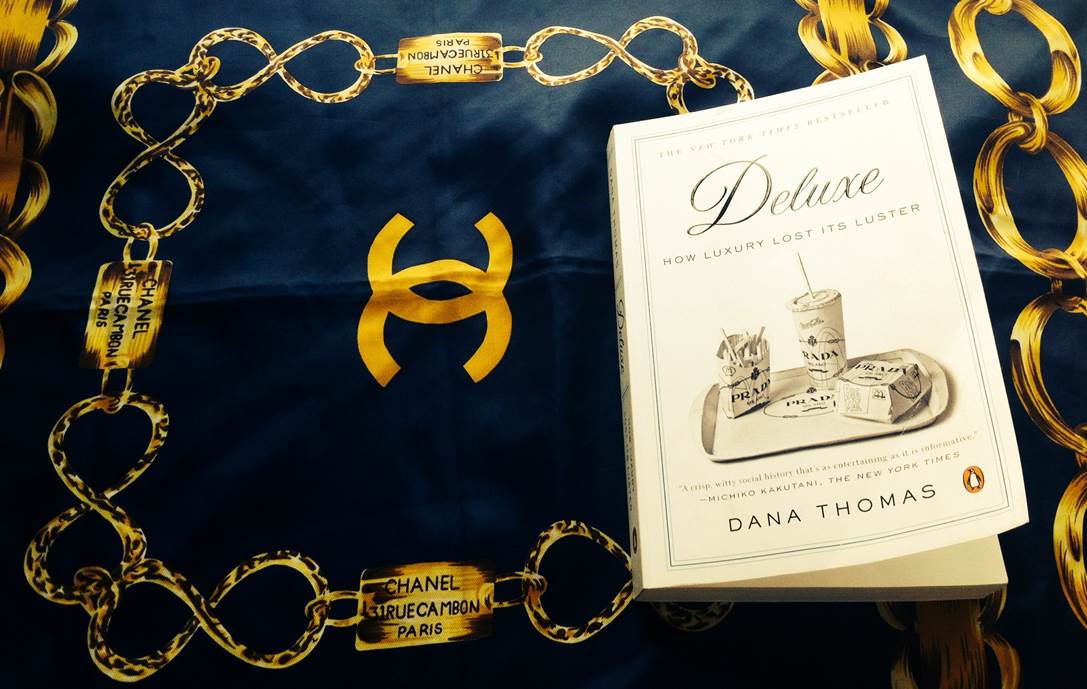Guess how Mademoiselle Chanel did her market research for the world’s most popular perfume? Dana Thomas’s Deluxe: How Luxury Lost Its Luster is certainly a luscious read on the history of luxury. What caught me by surprise was the number of business issues Dana dives into and the phenomenal job she does discussing them.
Coco Chanel: an icon, a visionary, and a women’s liberator (girls, you can thank her for renegading corsets). A classic example of the lasting impression Chanel left on fashion is her 1920 invention at the height of her fashion fame.
- The Granddaddy of modern perfumes is Chanel No. 5. World War II GIs fighting in Europe brought it home for their sweethearts. Marilyn Monroe declared it was all she wore to bed. In 1959, the Museum of Modern Art added No. 5’s packaging to its permanent collection, and Andy Warhol produced a silk screened image of the No. 5 bottle in a rainbow of colors. No. 5’s spicy oriental bouquet is the scent that young perfumers try to duplicate: it is the standard by which one measures a nose.
The genius of Chanel is in her market research, launch, and advertising for No. 5.
Birth of No. 5: Ernest Beaux, the Russian Czar’s official French perfumer concocted a series of exotic samples on Chanel’s request. No. 5 was born out of Chanel choosing his fifth proposition, construed of jasmine (still picked from the Mul family farms in southern France), ylang-ylang (from Africa), patchouli (from Indonesia), orange blossom, cloves, and about 75 other ingredients. Think about how different this would have been to the single floral perfume monopoly then and how truly luxurious her invention was – conjuring up exotic flora and spices from far off lands sounds luxurious even now.
So how did Chanel come up with something so different? Did she have a focus group? Was she solving a pain? Were her high-couture clients complaining about boring bourgeois perfumes? None of the above. She had a vision and dared to have an opinion. “A woman should smell like a woman and not like a flower”, Chanel’s famous quote nicely captures her stance on the mono-flora perfumes available then: boring & blasé. She didn’t ask if anyone would buy a multi-floral perfume. She simply made one that met her vision of what would complement the class, elegance, and beauty of women. She also chose a simple glass bottle – again, departing from the then popular fine handmade crystals – to convey how different No. 5 was. “Mademoiselle is proud to present simple bottles adorned only by “…precious teardrops of perfume of incomparable quality, unique in composition, revealing the artistic personality of their creator”, read one of the original marketing brochure.
Market Research: Chanel invited Beaux and some friends to a top restaurant in Cannes. Every time a stylish woman walked by, she discretely squeezed an atomizer and gently perfuming the air with No. 5. And each time, the women stopped, appearing enchanted by the unfamiliar, exotic scent. Thrilled, Chanel launched No. 5 on her return to Paris. Talk about a down to earth and sensible market research!
The Launch: No press, no top-tier placement in her store, no announcement. Completely asynchronous with the flashy A-list filled launches now commonplace, Chanel launched No. 5 slowly, stealthily and anonymously:
- She wore it herself. She gave bottles to a few of her high society friends. Soon the buzz began: “Have you heard Mademoiselle Chanel has a new perfume? When the buzz rose to a clamor, Chanel instructed Beaux to put No. 5 into production. “The success was beyond anything we could have imagined”, recalled Chanel’s friend Misia Sert. “It was like a winning lottery ticket.”
Advertising: While brands routinely spend $25 on advertising a new perfume today, Chanel spent a grand total of $0. But more than that, today’s perfumes have extremely short lifespans. Jacque Polge says, “When you look at the number of perfumes that are launched [these days] and how few remain…the difficulty is not only to succeed, but to last”. And last it has: Chanel No. 5 has been the world’s best selling perfume for more than 7 decades.
It is said that a bottle of No. 5 sells every thirty seconds somewhere in the world everyday. And it is the only perfume that hasn’t switched to synthetic essences. If you haven’t yet done your holiday shopping for that one special woman, you can thank me for the fantastic suggestion that now packs one hell of a start up lesson and visionary creator behind it!
